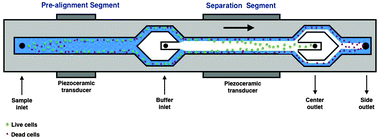Label-free concentration of viable neurons, hESCs and cancer cells by means of acoustophoresis†
Abstract
Concentration of viable cell populations in suspension is of interest for several clinical and pre-clinical applications. Here, we report that microfluidic acoustophoresis is an effective method to efficiently concentrate live and viable cells with high target purity without any need for protein fluorescent labeling using antibodies or over-expression. We explored the effect of the acoustic field acoustic energy density and systematically used different protocols to induce apoptosis or cell death and then determined the efficiency of live and dead cell separation. We used the breast cancer cell line MCF-7, the mouse neuroblastoma N2a as well as human embryonic stem cells (hESCs) to demonstrate that this method is gentle and can be applied to different cell populations. First, we induced cell death by means of high osmotic shock using a high concentration of PBS (10×), the protein kinase inhibitor staurosporine, high concentrations of dimethyl sulfoxide (DMSO, 10%), and finally, cell starvation. In all the methods employed, we successfully induced cell death and were able to purify and concentrate the remaining live cells using acoustophoresis. Importantly, the concentration of viable cells was not dependent on a specific cell type. Further, we demonstrate that different death inducing stimuli have different effects on the intrinsic cell properties and therefore affect the efficiency of the acoustophoretic separation.


 Please wait while we load your content...
Please wait while we load your content...